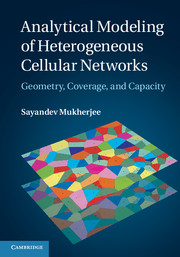Book contents
- Frontmatter
- Contents
- Preface
- Acknowledgemants
- List of notation
- List of acronyms and abbreviations
- 1 Introduction
- 2 Structure of the SINR calculation problem
- 3 Poisson point processes
- 4 SINR analysis for a single tier with fixed power
- 5 SINR analysis for multiple tiers with fixed powers
- 6 SINR analysis with power control
- 7 Spectral and energy efficiency analysis
- 8 Closing thoughts: future heterogeneous networks
- Appendix A Some common probability distributions
- Appendix B HCNs in LTE
- References
- Author index
- Subject index
Appendix B - HCNs in LTE
Published online by Cambridge University Press: 18 December 2013
- Frontmatter
- Contents
- Preface
- Acknowledgemants
- List of notation
- List of acronyms and abbreviations
- 1 Introduction
- 2 Structure of the SINR calculation problem
- 3 Poisson point processes
- 4 SINR analysis for a single tier with fixed power
- 5 SINR analysis for multiple tiers with fixed powers
- 6 SINR analysis with power control
- 7 Spectral and energy efficiency analysis
- 8 Closing thoughts: future heterogeneous networks
- Appendix A Some common probability distributions
- Appendix B HCNs in LTE
- References
- Author index
- Subject index
Summary
3GPP and LTE
The scale and complexity of design, manufacture, and deployment of wireless cellular systems make it all but impossible for a single-company proprietary architecture to gain traction in the global telecommunications market. Instead, cellular network operators and equipment vendors from all over the world have joined to form standards bodies at the national and international level in order to facilitate the evolution of cellular communication systems. At the present time, six national standards bodies (ARIB and TTC from Japan, CCSA from China, ATIS from North America, ETSI from Europe, and TTA from Korea) have combined to form a single international standards organization for wireless cellular communications, called the Third Generation Partnership Project, or 3GPP for short. The 3GPP partnership was first created to further the UMTS standard, which defined the so-called “third generation” of cellular communications using code division multiple access (CDMA) on the air-interface, but the name 3GPP was retained for the “fourth generation” using OFDMA. This fourth generation of cellular systems came to be known as the “long-term evolution” of the 3GPP standard, and is simply abbreviated as 3GPP-LTE, or just LTE for short.
Support for HCNs in LTE
3GPP standards are published as “Releases,” with a typical interval of 12 to 18 months between releases. As the universal mobile telecommunications system (UMTS) standard became mature and the standards activity ramped up on LTE, the same release (Releases 8 and 9) contained standards specifications for both UMTS and LTE.
- Type
- Chapter
- Information
- Analytical Modeling of Heterogeneous Cellular NetworksGeometry, Coverage, and Capacity, pp. 163 - 164Publisher: Cambridge University PressPrint publication year: 2014



